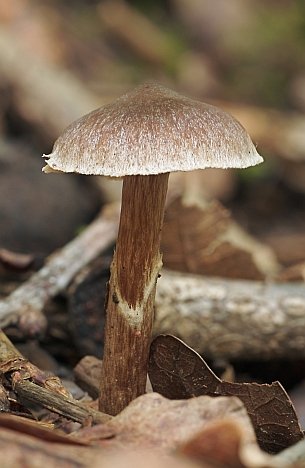The pelargonium webcap, Cortinarius flexipes (Pers.) Fr.
Classification
Kingdom Fungi
Phylum Basidiomycota
Class Basidiomycetes
Order Agaricales
Family Cortinariaceae
Genus Cortinarius
Synonyms
Agaricus flexipes Pers.
Syn. meth. fung. (Göttingen) 2: 275 (1801)
Cortinarius flexipes (Pers.) Fr.
Epicr. syst. mycol. (Upsaliae): 300 (1838)
Cortinarius paleaceus sensu auct. p.p.
fide Checklist of Basidiomycota of Great Britain and Ireland (2005)
Cortinarius paleiferus Svrček
Česká Mykol. 22(4): 276 (1968)
Hydrocybe flexipes (Fr.) M.M. Moser
in Gams 2: 168 (1953)
According to fungorum the current name is Cortinarius flexipes (Pers.) Fr. var flexipes.
Common names
Pelargonium webcap
Pixy webcap
Cortinaire à pied tortueux (French)
Bleicher Wasserkopf (German)
Pavucinovec ohybný (Slovak)
Topp-spindling (Swedish)
Description
Cap: 1-4 cm diameter, conical or bell-shaped then expanded and umbonate, dark brown/purple when moist, especially at the centre, drying pale fawn to ochraceous, covered in white fibrils or tiny scales which are particularly dense at the margin in young specimens
Stem: 3-8 cm long x 0.3-0.7 cm diameter, equal or slightly thicker at base, often curved, brownish, covered at first with the white cottony veil which forms a distinct but temporary annulus and cottony scales below; hollow in age.
Gills: adnate, broad, crowded, dark brown often with violet tinge.
Flesh: brownish-lilac, thin.
Odor: like geranium (Pelargonium).
Spore print: reddish-brown.
Spores: ellipsoid, warted, 7-9 x 4-6 µm.
Habitat and distribution: on the ground in damp woods, often under deciduous trees, and in boggy heaths. Found in Europe and America.
Season: autumn. Uncommon.
Edibility: unknown, but best to avoid, due to prevalence of toxins in other Cortinarius species.
Medicinal properties
Anti-tumor effects
Polysaccharides extracted from the mycelial culture of C. flexipes and administered intraperitoneally into white mice at a dosage of 300 mg/kg inhibited the growth of Sarcoma 180 and Ehrlich solid cancers by 80% and 70%, respectively (Ohtsuka et al., 1973).

My name is Austin Collins.
I've dedicated my life to Mushrooms.
I believe Mushrooms are the best kept secret when it comes to health and well being.
For that reason, I would like to share a company with you that in my opinion makes the best mushroom products on the market.
The company is called Noomadic Herbals, my favorite supplement they make is called "Mushroom Total".
I take their products every day and they have helped me think better and have more energy. Give them a try.
-Austin
Links
PilzePilze have some photo galleries.
References
Keizer P-J.
Pitfalls and traps: Cortinarius flexipes and Cortinarius sertipes.
Coolia. 1994 37(3):114-5.
Kuhner R.
Notes descriptives sur les agarics de France I. Cortinarius (suite), Telamonia et Hydrocybe.
[Descriptive notes on the agarics of France. I. Cortinarius, continued]
Bull Mens Soc Linn Lyon. 1961 30(3):50-65.
Lamoure D.
Critical survey of alpine Telamonia genus Cortinarius Fr. Agaricales 1. Some species smelling like Pelargonium.
Bulletin Mensuel de la Societe Linneenne de Lyon. 1991 60(5):152-6.
Ohtsuka S, Ueno S, Yoshikumi C, Hirose F, Ohmura Y, Wada T, Fujii T, Takahashi E.
Polysaccharides having an anticarcinogenic effect and a method of producing them from species of Basidiomycetes.
UK Patent 1331513, 26 September 1973.



